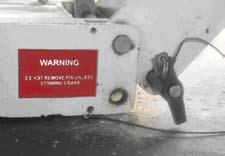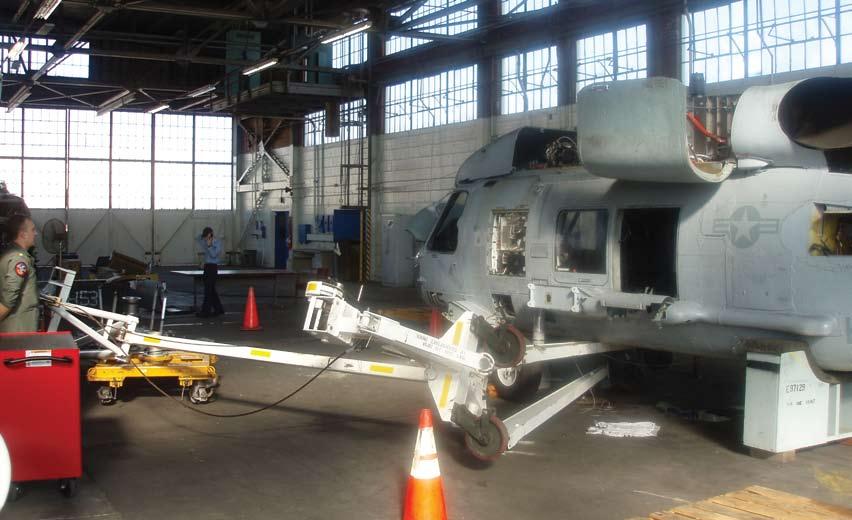
4 minute read
Risk Management for the Maintainer
from MECH Fall 2008
By LCdr. George Austin “T oday we need to get the rotor head off aircraft 105 to assist the PMI crew. Are you all set to get the work done?”
“Yes, Chief.” That short, deceptively clear conversation has occurred in helicopter squadrons all over the world. For HSL-49’s maintenance department, however, it resulted in a destroyed utility crane, a damaged helicopter, and some personnel who never will forget the day when they nearly were crippled or killed. This incident demonstrated the stark reality: while we had been examining our flight operations for ways to minimize and control hazards, we were not doing enough to train our maintainers on risk management.
Advertisement
This tool has become the cornerstone of the Navy’s war on the “Blue Threat” (self-induced mishaps). Originally introduced as a tool to prevent operational

mishaps, it has gained recognition as something that can be applied to every aspect of a service member’s life. When properly applied, risk management can help reduce the loss of lives and equipment from mishaps, whether they occur during combat operations or while driving home after work. Visibility on this topic has remained extremely high, with guidance available at every level. You find it everywhere: from OPNAVINST 3500.39B to the risk-management training, examples and tools on the Naval Safety Center website to the posters found in every workshop in the Navy.
The greatest hurdle to effective risk management has been the ability to properly assess risk and implement controls before mishaps occur. Generating a simple tool to assist this process has been problematic because of the complexity of daily life. Attempting to

define risks for every situation, as well as every possible contingency, is impossible, so organizations attempt to define high-risk operations in advance and use in-depth or deliberate risk management to provide guidance and combat the situation with education and training.
However, mishaps most often are the result of poorly executed time-critical risk management. By far the most often encountered and least rigid of the three levels, time-critical risk management is highly dependent on experience and communication, and it’s the hardest to train and reinforce.
The reason is two-fold. First, the military culture generally does not lend itself to junior personnel giving a significant amount of negative feedback to senior personnel. Commendations and positive recognition abound for the Sailors who take their tasking and report back upon successful completion.
Second, the high level of interpersonal trust that is an essential element to unit success can be a pitfall when it causes a situation where no one questions the decisions being made, even when they have doubts. Personnel unintentionally encounter hazardous situations because they believe their supervisor knew all the factors, both intrinsic and external, that could be encountered when they assigned the job. The most important training tool to give personnel, particularly junior personnel, is awareness of the level at which the command expects risk decisions to be made.
HSL-49 generated a risk-decision matrix to make personnel aware of where the command expects them to go to resolve questions and who needs notification when problems arise. There is no intention to hinder personnel from proactively executing a plan to overcome difficulties, but it makes them aware there is an expectation to review and communicate a risk-mitigation plan. It also provides an awareness and ability for concerns to be pushed upward to a higher level of command visibility to make sure we are making appropriate decisions at the right level in work tasking. Our matrix, included below as an example, is accompanied by extensive training and small-group discussion on how to implement it in the workplace. 1. An “X” denotes divisions/personnel needing notification of problems in that area and can be used in the decision process. 2. A “D” denotes the level of visibility that a decision holds and indicates the lowest level at which risk decisions should be made.
Effective risk management will continue to remain part science and part art, but tailoring this type of matrix to fit the needs of an individual unit may help
HSL-49 Risk Management Decision Matrix
Problem/Concern
PPE Training Safety Procedure Support Equipment Tools
Job Leader
D X X X X D
LPO/LCPO
D X X X X D
Maintenance Control
D X X X
QA
X X D X D
MO
D D D
CO
D D D
X personnel to make risk decisions at the appropriate level. It also ensures that hazards are communicated throughout the command, so that they can be avoided in the future.
LCdr. Austin is the quality assurance officer at HSL-49.
Analyst comment: This was the third accident in less than a year involving the A/S32A-44 aircraft utility crane, also referred to as “seat crane or hangar-deck crane.” All of these accidents involved improper operation because of unfamiliarity with support equipment (e.g., pulling the wrong pit pin at the wrong time), even though warning placards were attached at each pit-pin location. Two articles involving this crane were printed in this edition, and the third was published in the winter 2007 edition of Mech.
The NA 00-80T-96, WP 00600, pg. 9, paras. 37 thru 68, discuss the hazards associated with this crane and is highly recommended for review before operating since most operators seldom use the crane.
One more footnote: This same type of accident happened in my maintenance department in 2001. The result was a damaged crane and two E-2C propellers.
CWO4 Jim Stewart is the aircraft maintenance branch head and analyst at the Naval Safety Center.










